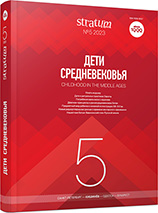Оконное стекло с поселения Горзувиты и Мангупского городища в Крыму: химический состав, происхождение и хронология в историко-культурном контексте
Window Glass from Gorzuvity and Mangup Fort in the Crimea: Chemical Composition, Origin and Chronology in the Historical and Cultural Context
Author(s): Olga S. Rumyantseva, Anna V. Mastykova, Valery E. NaumenkoSubject(s): History, Archaeology, 6th to 12th Centuries
Published by: Издательский дом Stratum, Университет «Высшая антропологическая школа»
Keywords: Crimea; Gorzuvity; Mangup; chemical composition; Byzantine sites; window glass; SEM-EDS; HIMT; Foy-3.2; Foy-2.1; Foy-2.2; glass recycling;
Summary/Abstract: Chemical composition of 39 window panes of the Early and Middle Byzantine periods was studied with SEM-EDS technique. They originate from the Gorzuvity settlement in the Crimea Southern coast with the ruins of two churches, and Mangup, the largest medieval fortress in the SW Crimea. The presence of glass of groups Foy-3.2/2.1 and HIMT suggests that the earliest structures with glazed windows could have emerged on Mangup in the 5th century at the latest — i. e., before the construction of the Byzantine fortress. A homogenous composition of glass from Gorzuvity suggests a single period of glazing windows of structures existing here — the “lower” church with a shrine dated probably to the 11th century (terminus ante quem for the church construction) and some stone structures at the settlement. 37 samples represent natron glass of the Egyptian origin. Most of window panes are related to the 9th—10th/11th cc. Their glass belongs to the series Foy-2.2, the result of the recycling of the earlier glass of the 2nd half of the 5th/6th — mid-7th centuries (series Foy-2.1). It suggests that the remains of monumental structures of the early Byzantine period (window panes and probably tesserae) were used as raw materials during the construction campaign at Gorzuvity and Mangup in the middle Byzantine period. Two fragments from Mangup of mixed-alkali composition originate from the contexts of the 15th c., where they could get from disturbed earlier deposits.
Journal: Stratum plus. Археология и культурная антропология
- Issue Year: 2023
- Issue No: 5
- Page Range: 383-402
- Page Count: 20
- Language: Russian
- Content File-PDF

